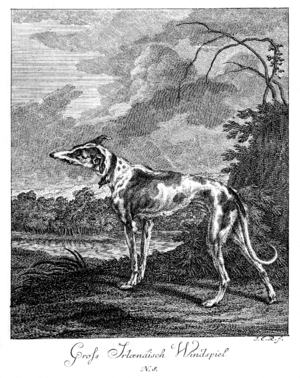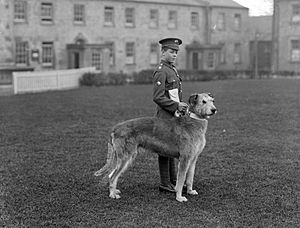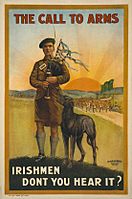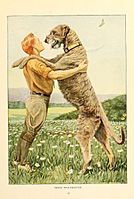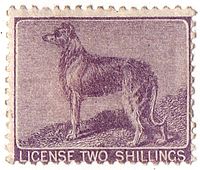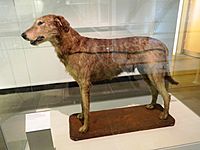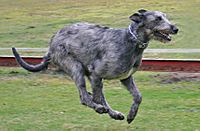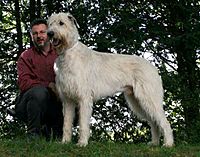Irish Wolfhound facts for kids
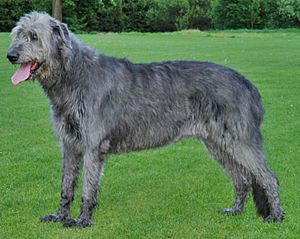 |
|||||||||||||||||||||||||||||||||||||
| Other names |
|
||||||||||||||||||||||||||||||||||||
|---|---|---|---|---|---|---|---|---|---|---|---|---|---|---|---|---|---|---|---|---|---|---|---|---|---|---|---|---|---|---|---|---|---|---|---|---|---|
| Origin | Ireland | ||||||||||||||||||||||||||||||||||||
|
|||||||||||||||||||||||||||||||||||||
|
|||||||||||||||||||||||||||||||||||||
| Domestic dog (Canis lupus familiaris) | |||||||||||||||||||||||||||||||||||||
The Irish Wolfhound is a very large dog. It is one of the tallest dog breeds in the world. These dogs are known for their huge size and strong bodies. People have admired them for centuries. They even appear in old stories and poems. Long ago, Irish Wolfhounds were used as guardian dogs and for hunting wolves.
Today, these dogs are still prized by hunters. They are known for their ability to help catch game.
Contents
History of the Irish Wolfhound
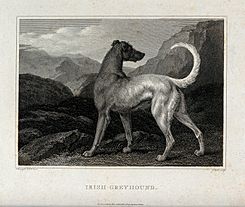
Early History: Before the 1800s
The Irish Wolfhound has a very long history. In the year 391, a Roman leader named Quintus Aurelius Symmachus received a special gift. He got seven "canes Scotici" (which means "Irish dogs"). These large dogs were used to fight lions and bears. Everyone in Rome was amazed by them. The word Scoti was a Latin name for the ancient Irish people.
Some people believe this type of dog is very old. The ancient Irish, called Gaels, used wolfhounds for hunting. They called them Cú Faoil, which means "wolfhound." Dogs were important in old Irish laws and stories from the 6th century. The word cú (hound) was often used for brave warriors and kings. It showed they deserved respect and loyalty. A famous mythical warrior, Cú Chulainn, got his name because he replaced a fierce guard dog. His name means "hound of Culann."
However, experts who study old dog bones say something interesting. They have not found bones of dogs as big as today's Irish Wolfhounds from ancient times. This suggests that the very large size of the Irish Wolfhound might be a more recent development. So, the dog of Cú Chulainn was probably not as huge as people imagine.
Hunting dogs were very valuable. They were often given as gifts to important people and foreign nobles. Around 1210, King John of England gave an Irish hound named Gelert to Llywelyn the Great, a prince in Wales. A poet later wrote a famous poem about this dog.
In 1571, Edmund Campion wrote about the hounds used to hunt wolves in Ireland. He said they were "bigger of bone and limb than a colt". Because these dogs were so popular, many were sent to royal families in Europe. This meant there were fewer wolfhounds left in Ireland. To fix this, Oliver Cromwell made a rule in 1652. He wanted to make sure enough wolfhounds stayed in Ireland to control the wolf population.
Writers in the 1700s talked about the Irish Wolfhound's great size and strength. They also noted how rare the dogs were becoming. In 1790, Thomas Bewick described them as the largest and most beautiful dogs. He said they were about 36 inches tall. They looked like a greyhound but were stronger. He also noted their gentle nature.
The last wolf in Ireland was killed in 1786. It was thought to be killed by a group of wolfdogs. After this, the wolfhounds became symbols of status. Only a few families, often descendants of old Irish leaders, still owned them. These dogs were seen as the last of their kind. By the late 1700s, there were very few wolfhounds left in Ireland.
Modern Irish Wolfhound: Revival of the Breed
Captain George Augustus Graham (1833–1909) is known for bringing the Irish Wolfhound breed back. He worked hard to find dogs that were close to the original breed. He believed that the Scottish Deerhound and Great Dane breeds came from the wolfhound. So, he used these breeds a lot in his breeding program. He also used a Borzoi and a "Tibetan wolfdog" to help bring the breed back.
In 1885, Captain Graham started the Irish Wolfhound Club. He also created a "Breed Standard." This standard described what an ideal Irish Wolfhound should look like. In 1902, the Irish Wolfhound became the official mascot of the Irish Guards, a famous army regiment.
The Irish Wolfhound is now a national symbol of Ireland. It is also used as a symbol by rugby teams. The Ireland national rugby league team is called the Wolfhounds. The Irish Rugby Football Union also named its second-level national team the Ireland Wolfhounds in 2010. You can even see the Irish Wolfhound on some tax stamps in Ireland. In the video game The Elder Scrolls V: Skyrim, all the dogs are Irish Wolfhounds.
-
Champion Irish Wolfhound Patrick of Ifold, Ulster Museum
Characteristics of the Irish Wolfhound
The Irish Wolfhound is famous for its very large size. Male dogs are usually between 81 and 86 centimeters (32 to 34 inches) tall at the shoulder. They should weigh at least 54.5 kilograms (120 pounds). Female dogs are a bit smaller, at least 71 centimeters (28 inches) tall and 40.5 kilograms (89 pounds). They are built more strongly than a Scottish Deerhound but are not as heavy as a Great Dane.
Their coat is rough and hard. It covers their head, body, and legs. The hair around their beard and over their eyes is especially wiry. They can come in many colors. These include black, brindle (striped), fawn (light brown), grey, red, or pure white. They can also be any color seen in the Deerhound.
The Irish Wolfhound is a sighthound. This means they hunt by seeing their prey, not by smell. They have a strong, long neck and hold their head up high. They should look longer than they are tall. They should also look like they could catch and kill a wolf.
Temperament and Personality
Irish Wolfhounds have unique personalities. They are often known for their own special quirks. Despite their huge size, they are usually not destructive or wild inside the house. This is because they are generally calm, smart, and quiet dogs. They are easygoing and peaceful by nature.
Wolfhounds often form a very strong bond with their human families. They can become sad or destructive if they are left alone for too long. An Irish Wolfhound can be a very good and impressive guardian. They get very attached to their owners and other dogs they grow up with. This means they don't adapt easily to new homes.
These dogs were bred to think for themselves when hunting. This means they are not always keen on defending their space. Their old saying describes them best: "gentle when stroked, fierce when provoked." This means they are usually calm and kind. But they will be brave and protective if they or their family are in danger.
Irish Wolfhounds are not usually aggressive towards other dogs. However, when they play, they might "course" another dog. This is a natural hunting behavior, not fighting. Most Wolfhounds are very gentle and patient with children. They are also quite easy to train. They respond well to clear, gentle, and consistent guidance.
People love Irish Wolfhounds for their loyalty, affection, patience, and devotion. Even though they were once used as watchdogs, they are often too friendly with strangers to be good guard dogs. However, their large size can scare people away. When protection is truly needed, these dogs are fearless. They are very sensitive to bad intentions. This makes them excellent guardians for their families.
Health and Lifespan
Like many large dog breeds, Irish Wolfhounds do not live as long as smaller dogs. They usually live between 6 and 10 years, with 7 years being the average. The main causes of death for Irish Wolfhounds are heart disease (called dilated cardiomyopathy) and bone cancer.
Like all dogs with deep chests, they can also get a serious stomach problem called gastric torsion (often called "bloat"). This is when the stomach twists. They can also have a problem with their liver called a portosystemic shunt.
Studies have shown that Irish Wolfhounds in the United States lived to an average age of 6.47 years. Bone cancer was the most common cause of death. A more recent study in the UK found the average age of death to be 7 years. Some studies also suggest that neutering (removing a dog's reproductive organs) might be linked to a higher risk of bone cancer in some breeds.
See also
 In Spanish: Lobero irlandés para niños
In Spanish: Lobero irlandés para niños


